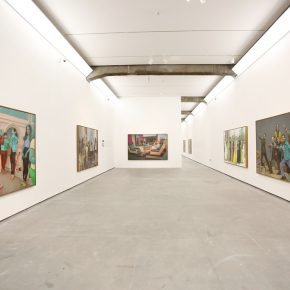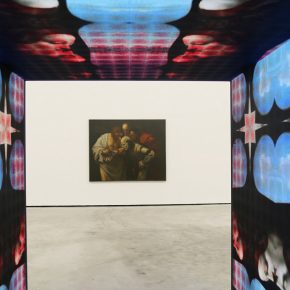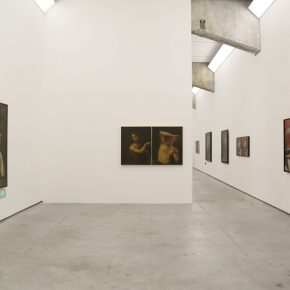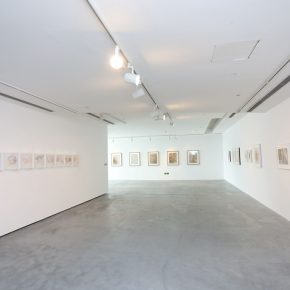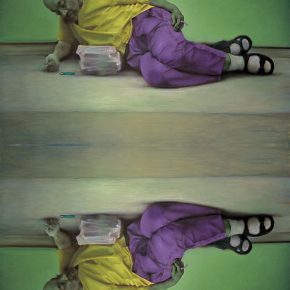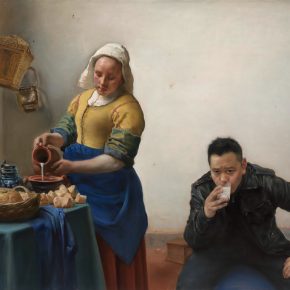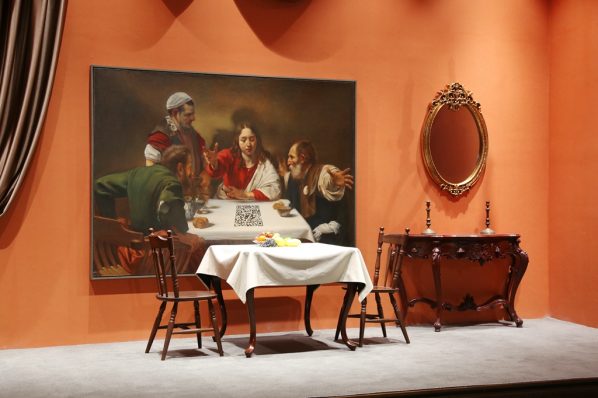
In 1983, when Pang Maokun went to Liangshan, where the Yi nationality live to observe and learn from life, the strange local atmosphere touched his heart. “A strange atmosphere clings to the people like some dim sleepiness; from the outlines of those individual faces, the patterns of their utensils, and the texture of their pleats, it seems as if you could touch a sleeping thought or some underlying primordial rule.” Inspired by this, he painted a masterpiece, The Apples are Ripening—the land, an old woman of Yi nationality, and an apple orchard behind her; in the sun, the apples on the branches glow and the character narrows her watchful eyes. After that, he continued to draw paintings with ethnic minority characters as the theme, and created works such as the First Rays of the Morning Sun in the Open Land (1987), Weaving (1988), Feeding (1991), etc. The characters in these paintings, whether sitting or standing, staring out in front or looking back in sorrow, are all impressive, which has established the artist’s reputation for “classical beauty” in his early paintings.
The recent “The Encounter with There-Being—Pang Maokun Art Exhibition (2009-2019)”, which can be divided into the “Stage Series”, “Tour Series”, “Mirror Image Series” and “Folding Series”, is held at Shanghai Minsheng Art Museum. The works on the show created by the artist contrasts with his early paintings—when our vision is beset with the paintings on the four walls, distinctive in style and closely related to contemporary life, we can feel the visual impact, and we cannot help but ask this question: “How has this artist changed from expressing the theme of ethnic minorities to observing contemporary society?” At the same time, these works also take shape with a strong intertextuality with the artist’s early paintings—his art has consistently shown an inner gaze from the heart to the eye. The inquiry on the relationship between the two constitutes the main clue to our understanding of Pang Maokun’s art.
From the rural to the urban: the surrounding living environment is more likely to offer artists a sense of integration.
From the late 1970s to the early 1980s, in the art world of China, there first appeared the “Scar Art” and “Countryside Painting”, which were active in Southwest China and are represented by Luo Zhongli, Cheng Conglin and Gao Xiaohua. Later, another influential “85 Thoughts of art” appeared in Mainland China. It was during this period that Pang Maokun, born in 1963, entered school to begin his systematic art training.
The psychologist David Myers points out: “When analyzing another’s behaviors, we, as observers, tend to underestimate the impact of the environmental situation and to overestimate the impact of personal disposition and attitudes.” Why did the artist choose these minorities as the theme of his paintings in the first place? On this issue, it is easy to fall into a subjective statement, while ignoring the large social background. Therefore, first of all, we must make it clear that Luo Zhongli, Cheng Conglin, Gao Xiaohua, the representatives of the “Scar Art” and “Countryside Painting”, all come from Sichuan Fine Arts Institute, the main position of the “Scar Art” and ” Countryside Painting”. Under the influence of these alumni artists before him, Pang Maokun unconsciously chose the minority subjects which deeply touched him as the main theme of his creation, which also ranked him within the group of artists of “Countryside Painting”.
It is the art theorist Shao Dazhen who first paid attention to Pang Maokun’s art. However, in the discussion of his early articles, Mr. Shao Dazhen did not include Pang Maokun’s art in the category of “Countryside Painting”. On the contrary, he pointed out at that time that Pang Maokun’s attention to the subjective spirit of the characters in his artworks indicated the changes that were taking place in realistic oil painting in Sichuan and that young painters at that time were ever more aware of “the importance of expressing deep-seated and high-level spiritual realms in painting”. 【1】 In the form and language of paintings, young painters represented by Pang Maokun undoubtedly expanded the developmental path of “Countryside Painting”.
In the 1990s, with the development of China’s market economy, the expansion of urban construction widened the gap between the urban and rural areas. During this period, Sichuan Fine Arts Institute has given birth to a new generation of painters— Feng Zhengjie, Guo Jin, Zhong Biao, Zhao Nengzhi, Xin Haizhou, He Sen, Chen Wenbo, who are presented through visualization the new landscape and humanistic situation of the urban culture of that era. At that time, Pang Maokun completed the transformation from student to teacher, and begun to face the artistic ecology as a teacher. In the complex relationship of that era, Pang Maokun began to explore a variety of languages for painting. In the middle and late 1990s, he integrated his art more into the real life around him and completely changed his painting style—he no longer used the theme of ethnic minorities and classical painting as in his earlier paintings, but instead adopted a symbolic language to express the urban theme. During this period, the artist created a series of paintings, such as Nightmare (1997), Touch (1997), Floating (1998), and Fragment (1998).
Nikolay Gavrilovich Chernyshevsky once said: “The environment affects human growth, but it does not exclude free will.” In response to the question as to why he chose such a change in the selection of subject matters in the 1990s, Pang Maokun believed that although he still chose the theme of Yi nationality in his graduation paintings, as a graduate student, he had already begun to study in depth the language of classical oil painting. In an interview with the media, he admitted that his greatest experience at the time was that the bodies and themes of paintings were actually less important than the languages used in paintings. Under the combined control of the environment and free will, Pang Maokun completed the natural transition from ethnic minority themes to urban themes. From his point of view, “The surrounding life is more likely to give the artist a sense of integration”.
As the experience of art history shows, the changes of times and the social environment will inevitably lead to a change of artistic style and language for painting. In the new century, with the progress of reform and opening-up, China is moving towards a consumer society step by step. In this social context, many artists are no longer as interested in ideas as they were in the new trend of artistic thoughts in 1985. On the contrary, these artists begin to deviate from the grandiose narration of the past art to express an individual’s experience of survival. From the very beginning, Pang Maokun consciously or unintentionally kept his distance from contemporary art that emphasized the expression of ideas, under the influence of the environment of this consumption era, Pang Maokun’s art has undergone tremendous change.
From the heart to the eye: reaching the heart through artworks
“To me, the most appealing thing about people of the Yi nationality lies on their quiet sitting posture. It seems that they want to maintain the dignity and solemnity of the universe in such stone-like silence. It can be said that, in this silence, they understand the universe and life in a simpler way than we do. These feelings excite me very much.” At first, Pang Maokun found a simpler way to understand the universe and life in the stillness of ethnic minorities. While at college, he spent eight months carving a piece of work just to find a balance between a certain rational spirit and a strong sense of life. Obviously, the artist succeeded. Now, in the hustle and bustle of city life, by watching his artworks during this period, a spiritual consolation can be obtained.
Mr. Shao Dazhen has noticed the characteristic of the “harmony of life” in Pang Maokun’s artistic expression, and called it an artistic temperament with “deep philosophical thinking”. From his perspective, Pang Maokun’s “artistic language is classical, close to the classical artistic language of the Pre-Raphaelites, but the spirit contained in his paintings is modern. “【2】 The critic Yin Shuangxi has also taken note of this. He commented: “Pang Maokun’s early artworks are reminiscent of the temperament of Sandro Botticelli in the early Italian Renaissance—the faint melancholy, the desire for a better life, the retention of past memories, and the pursuit of eternal value in a short life. This artistic temperament runs through Pang Maokun’s creation in different periods. Therefore, although the artist’s works have undergone periodic changes in style, its inherent artistic characteristics have maintained continuous stability.【3】
This can be further corroborated by an article written by Pang Maokun in his early years: “Art is not about guiding people to find the laws of objective material (this is the task of science). So, obviously, art is about leading people into the heart through art itself…. Artists have to explore deeper levels of the spiritual world, where feelings become deeper.”【4】
After paying attention to the themes on ethnic minorities for a period of time, Pang Maokun began to focus on urban life and began to depict urban women. For example, the Quiet Rainbow in the Sky (1993) depicts a woman sitting in a quiet mountain, who can hardly hide her sorrow although being far from the city. Shown on the painting the Woman Sitting Straight Up Inside the Red Door (1993) is a woman with a cold face sitting on sofa indoors. Her gaze is fixed on a point, as if she were thinking about a serious matter, or she looks like simply a body drawn away from the mind, forming a cross-view with the viewer or artist. During this period, the artist’s painting style has changed a lot however the artist himself did not use a painting theme to preach his art. His art touched the audience with the inner gaze born from the heart. It is precisely because of this direct inner gaze that, despite the changes in his artistic style—from the figurative style of portraying urban women in the early 1990s, to the symbolism during the middle and late period of the 1990s, and to his series of works after 2000 that we will deal with later, we can never fail to feel freshness when we appreciate his artworks.
“Action is an idea externalized”. In his 40 years as an artist, Pang Maokun has always used a philosophical thinking to maintain his concern for reality and dialogue with the present era. He reconstructs a social formation of being watched for the viewer with his paintbrush, which then constitutes another line of our understanding of Pang Maokun’s art.
Classicism and realism are combined to convey multiple experiences in life
It is commendable (to quote the critic Yin Shuangxi) that “Pang Maokun has never changed his pure heart with an increase with age.” Nor has Pang Maokun stopped his artistic exploration though he is now recognized as an artist. Starting with The Apples Are Ripening, created in the 1980s, Pang Maokun has been looking for a comprehensive form and perspective to effectively convey his multiple experiences of life.
Let’s return to the exhibition itself. Pang Maokun’s exhibition at the Minsheng Art Museum, focusing on the artist’s creation in the last decade with a retrospective narrative angle and a modern method of presentation, is a comprehensive and three-dimensional display of the artist’s rich creative experiences and artistic exploration. The four units displayed in the exhibition are not only an echo to his previous important solo exhibitions, but also contain philosophical thoughts such as “observation and representation”, “virtuality and theater”, “mirror and dasein”, “observation and freedom” and so on.
“Life is a play, and vice versa.” In the works of Stage Series, the artist reconstructs his perception of reality in the form of art: the facade and plane of the stage are composed of two blocks of color; the stage setting effect is created by means of lining and props; and the dynamic scenes of the characters on the stage are presented through juggling or other performances, so as to create a sense of strangeness that has never been appreciated by the audience. Although in order to highlight the absurdity and heterogeneity of life itself and to hide the surreal self-spirit at the same time, the artist has deliberately retained more fragments of daily life in the Viewing the Floating World series, the artist’s attempt to change the original pattern once and for all has broken the original order and once again created a sense of isolation from reality. “Traditional mirrors or the digital variants built with today’s technical tools that further expand imaging capabilities, are key interesting media in these relationships. On the one hand, media plays the role of a screen, and help people project themselves and realize their self-acoustic images; on the other hand, while presenting people’s mirror images, the media also promote people’s self-illusions, which turn into barriers to self-awareness and, of course, to the relationship between oneself and others (the world) just like a curtain.” The Mirror Image Series is not an attempt to answer any question. Instead, it represents a wish to show the feelings of the artist while facing these questions in the contemporary context, and prompts the spectator to think.
It is worth mentioning that, at the exhibition site, through the application of situation theaters, curtains, passageways, double-sided mirrors and so on, the curator Yin Shuangxi has created such an interaction between the audience and the works that audiences can not only watch, but also be watched. This plan, which constructs another narration worth watching over the whole exhibition, has some profound meaning.
Today, as science and technology play an increasingly important role in the development of society and bring about great changes, some of the things that we once believed in have become difficult to be identified with and new technologies make it even more difficult for us to determine the identity of ourselves. Inspired by the development of science and technology as well as the times, the artist uses the language of classical painting and looks for, in the classical works of the ancient masters, interactions with contemporary life—camera, mobile phone, two-dimensional code, artificial intelligence, and so on in his latest works Folding Series, so as to aggregate multiple connections between time and space, between the self and others, between the past and the present, so that more possibilities can be created.
The rich works and distinctive styles in the exhibition show multiple encounters between people, between people and nature, and even between the artist himself and society as well as the whole history of art, which conveys the artist’s multiple insights into life, or the “expansion of existence” discussed by Martin Heidegger, namely “dasein (presence)”, for which this exhibition is designed. From classical style to symbolism, from paying attention to reality to finding a balance between classical art and reality, Pang Maokun has achieved a transcendence of himself every time he has tried. And his every transcendence is deeply embedded in his philosophical thinking of the world. It is in here that “the deposits of life can thus be revealed, and the meaning of life is contained.”
Text (CN) by Yang Zhonghui, edited by Sue/CAFA ART INFO
Photo Courtesy of the Artist and the Organizer
【1】“Classical and Modern-On Pang Maokun’s Oil Painting language”,
Shao Dazhen, No.7, Yanhuang Art, 1992.
【2】Ibid
【3】P 501, Observation: An Anthology of Artistic Criticism by Yin Shuangxi (II), Yin Shuangxi, Hebei Fine Arts Publishing House, Hebei.
【4】 “Understanding or Experience of Art”, Pang Maokun, P11, Fine Arts, No.10, 1985.



